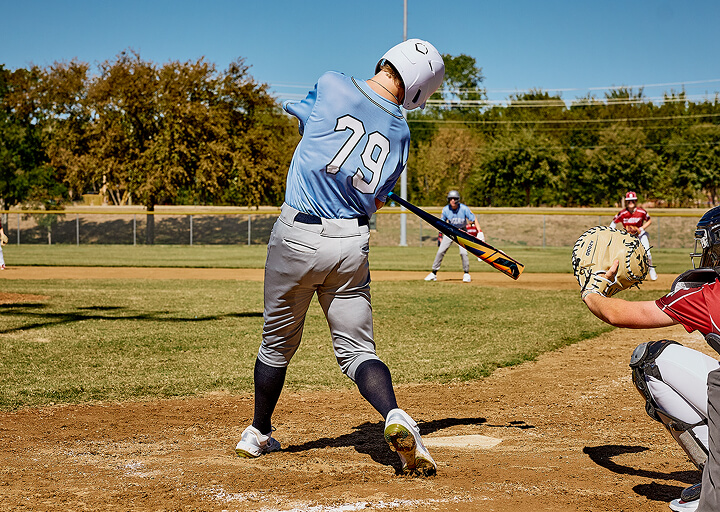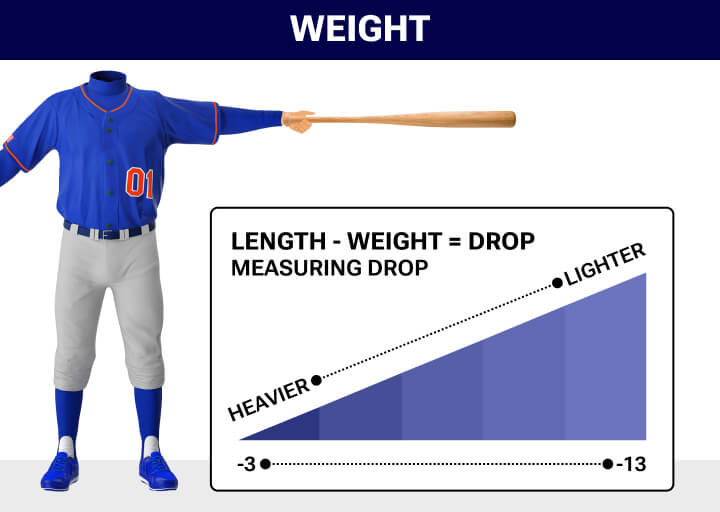Everything You Need to Know About Bat Drop

When shopping for a baseball or softball bat, you’ve probably come across terms like “drop weight” or “bat drop” and wondered what it all means. Don’t worry—you’re not alone! In this blog, our experts break down what bat drop is, why it matters, and how to choose the right one for your playing style.
Key Takeaways
- What is Bat Drop? — Bat drop (bat drop weight) is the difference between a bat’s weight and its length. A bigger bat drop indicates a lighter bat, while a smaller bat drop indicates a heavier bat.
- Why Does Bat Drop Matter? — Bat drop is important because it affects a bat’s power, control, and overall performance. Not all bat drop weights are suitable for all players.
- How to Choose the Right Bat Drop Weight — Learn how to choose bat drop by age, skill level, player comfort, and league rules.
- Does Material Affect Bat Drop Weight? — A bat’s material impacts its drop weight and performance characteristics.
- Additional Considerations for Buying a Baseball or Softball Bat —In addition to bat drop, consider barrel size, grip and handle, material, feel, balance, and your budget.
What is Bat Drop?
In baseball and softball, bat drop — or bat drop weight — is the difference between a bat’s weight (in ounces) and its length (in inches). It’s written as a negative number, like -10 or -3. For example, if a bat is 30 inches long and weighs 20 ounces, the bat drop is -10 (30 minus 20).
A bigger bat drop (like -10 or -12) means the bat is lighter, which makes it easier to swing. In contrast, a smaller bat drop (like -3) means the bat is heavier relative to its length.
Why Does Bat Drop Matter?
Bat drop matters because it helps players find the perfect balance between power and control when they swing. A lighter bat (with a bigger bat drop, like -10 or -12) is easier to handle and swings faster, which is great for younger players or those still developing their strength and technique.
A heavier bat (with a smaller bat drop, like -3) gives more momentum and power behind each hit, which is ideal for older, stronger players who can handle the extra weight. Choosing the right bat drop weight can make a big difference in player comfort and performance.
How to Choose the Right Bat Drop Weight
Choosing the right bat drop weight comes down to your age, skill level, and what feels comfortable when you swing. For younger players, a higher bat drop is typically the way to go. These lighter bats are easier to control and help newer players develop good swing mechanics without feeling weighed down. As players get older and stronger, they’ll often transition to a lower bat drop, like -5 or -3.
Although the right bat drop ultimately depends on your comfort and league regulations, we’ve outlined some general guidelines you can follow to get started.
| Bat Drop by Age | ||||
|---|---|---|---|---|
| Player Age | Recommended Bat Drop Weight | Recommended Bat Length (in) | Recommended Bat Weight (oz) | Bat Certification |
|
5-7 |
-12 to -13 |
24-26 |
11-14 |
USA Baseball or USSSA |
|
8-10 |
-10 to -12 |
26-29 |
14-19 |
USA Baseball or USSSA |
|
11-12 |
-8 to -10 |
29-31 |
19-23 |
USA Baseball or USSSA |
|
13-14 |
-5 to -8 |
30-33 |
22-28 |
BBCOR or USA Baseball |
|
15+ |
-3 |
31-34 |
28-31 |
BBCOR (required) |
The Baseball Bat Drop Test
A good rule of thumb is to test a few bats before purchasing. Hold the bat out in front of you with one hand for about 10 seconds — if it feels manageable, the weight is likely a good fit.

Bat Drop and League Regulations
League regulations play a big role in what bat drop you can use. Different leagues have specific rules about bat certifications and drop weights to ensure fair play and safety. Using the wrong drop weight or certification could lead to penalties—or even disqualification.
For younger players in youth leagues, bats with a higher drop weight are typically allowed. Most youth leagues require bats with USA Baseball or USSSA certifications, so make sure to look for the right stamp on your bat.
As players get older and move into middle school and junior high leagues, the allowed drop weight starts to decrease. Many leagues shift to -8 or -5 bats to prepare players for the heavier bats required in high school.
Once you hit high school and college, the rules get stricter. Bats must meet BBCOR certification, which means they’re limited to a -3 drop. This regulation ensures that non-wood bats perform similarly to wood bats and reduces the risk of balls being hit at dangerous speeds.
Does Material Affect Bat Drop Weight?
Bats are typically made from either aluminum alloy, composite materials, or wood, and each material impacts the bat’s drop weight and overall feel.
- Aluminum and alloy bats are lightweight and durable, making them popular for players who want a higher drop weight. They are also easier to swing and have good pop, making them a great choice for younger players or anyone who values bat speed over raw power.
- Composite bats, made from materials like carbon fiber, are usually even lighter than aluminum bats. This allows for higher drop weights without sacrificing durability or performance. Composite bats often have a larger sweet spot and less vibration on contact, which is a bonus for players working on their hitting skills.
- Wood bats are naturally heavier and typically have a much smaller drop weight if any at all. For example, most wood bats used in high-level leagues have a drop weight close to 0, meaning their weight and length are nearly the same. That’s why wood bats are usually reserved for advanced players who can handle the added heft and want the classic feel and power they provide.

Additional Considerations for Buying a Baseball or Softball Bat
Finding a bat that feels like a natural extension of your swing doesn’t stop at determining the right bat drop. Below are some additional factors to consider before making a purchase to help you step up to the plate with confidence:
- Barrel Size: A larger barrel diameter (like 2 5/8 inches) provides a bigger sweet spot, which can be helpful for players working on consistency.
- Grip and Handle: A good grip reduces vibration and improves comfort, while handle thickness affects how the bat feels in your hands.
- Material Preference: Decide between aluminum, composite, or wood based on your needs. Aluminum is lightweight and durable, composite offers performance perks like reduced vibration, and wood is great for training and advanced play.
- Budget: Bats can range from affordable to premium prices. Set a budget that fits your needs, but remember, a more expensive bat doesn’t always mean better performance for every player.
- Feel and Balance: Always test a bat if possible. A balanced bat might feel more comfortable, while an end-loaded bat adds power for experienced hitters.
Have Fun Out There!
Choosing the right bat comes down to understanding what works best for your swing, and bat drop plays a huge role in that. The most important thing is finding a bat that feels comfortable and helps you play like a pro. Ready to hit the batter’s box? Check out the selection of baseball bats available at Academy Sports + Outdoors!


